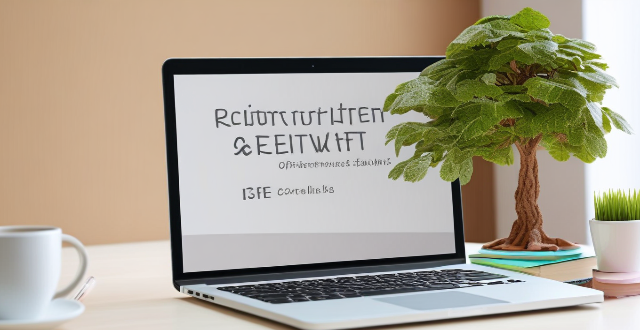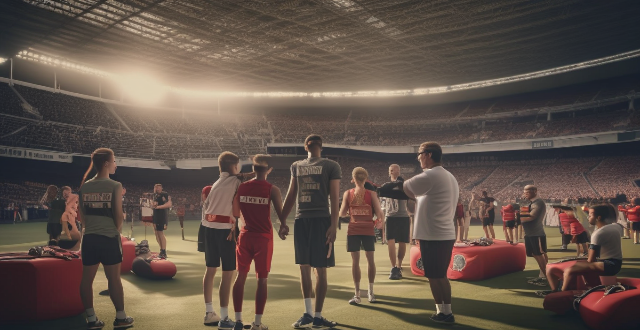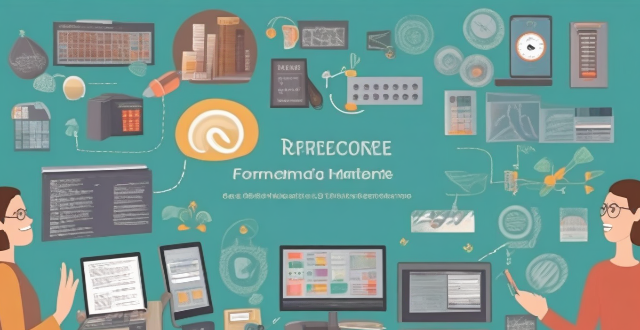Motivate Note

What are the benefits of using a digital tool for note-taking ?
The article discusses the advantages of using digital tools for note-taking, which include increased efficiency, improved learning and retention, environmental benefits, and collaboration opportunities. Digital notes can be taken quickly, organized easily, searched efficiently, and accessed from anywhere. They also offer visual aids, audio recordings, linking capabilities, and review options that enhance learning and retention. Additionally, digital note-taking reduces paper waste, energy consumption, and physical storage needs, contributing to a more sustainable environment. Finally, digital tools facilitate collaboration by allowing note sharing, real-time editing, version control, and feedback mechanisms. Overall, digital note-taking is an optimal choice for students, professionals, and anyone looking to optimize their note-taking experience.

How can mind maps be used to enhance note-taking and organization ?
Mind maps are an effective tool for organizing information, enhancing memory recall, and improving note-taking. They offer a visual representation of complex ideas, making it easier to understand and remember them. Mind maps can be used in various ways, such as organizing information, enhancing memory recall, and improving note-taking. They utilize visual associations, hierarchical structures, and flexibility to aid in understanding, remembering, and applying complex information in different contexts. Examples of using mind maps include studying, project planning, brainstorming, and taking meeting notes.

Can you recommend any effective study apps ?
The text provides a topic summary of effective study apps that can help students stay organized, focused, and motivated. The apps include Quizlet, Forest, Evernote, Khan Academy, and Duolingo. Quizlet is a flashcard app with various modes of studying including flashcards, practice tests, and games. Forest helps users stay focused by planting virtual trees while studying. Evernote is a note-taking app that allows users to organize their notes into notebooks and folders. Khan Academy is a free online learning platform that offers video lessons and exercises on a wide range of subjects. Duolingo is a language learning app that uses gamification techniques to keep users engaged and motivated. The text concludes by encouraging readers to try these apps and see which ones work best for them.

How do successful sports leaders motivate their team members ?
Successful sports leaders motivate their teams through clear objectives, positive reinforcement, encouragement, leading by example, communication, building team spirit, continuous development, resilience, and celebrating achievements.

What are the best iPhone apps for productivity ?
Productivity is a key aspect of modern life, and having the right tools can make all the difference. For those who use iPhones, there are numerous apps available that can help boost productivity. Some of the best ones include Evernote, Todoist, Trello, Microsoft Outlook, Notion, Google Drive, Apple Reminders, Slack, Asana, and Bear. These apps cover a wide range of needs, from task management to project collaboration to note-taking. By using these apps effectively, you can boost your productivity and achieve more in less time.

What are the most effective note-taking methods for students ?
The text discusses five effective note-taking methods for students, including the Cornell Method, Mind Mapping, Outlining, Sentence Method, and Charting. Each method has its own advantages and disadvantages, and may be more suitable for certain types of classes or subjects. The text emphasizes the importance of active learning and engagement with the material in order to retain information and review notes efficiently.

How can I improve my note-taking skills during lectures ?
Note-taking is a crucial skill for students, especially during lectures. It helps you retain information, organize your thoughts, and review the material later. Here are some tips on how to improve your note-taking skills during lectures: ## Use the Right Tools ### Choose the Right Notebook or Device - **Spiral-bound notebooks** are great for taking notes because they stay open and flat. - **Digital devices** like laptops or tablets can be useful, but make sure they don't distract you from the lecture. ### Use Appropriate Pens or Pencils - **Pens with comfortable grips** reduce hand fatigue and allow you to write for longer periods. - **Mechanical pencils** don't need to be sharpened and provide consistent line width. ## Develop Effective Techniques ### Practice Active Listening - **Focus on the speaker** and avoid distractions. - **Listen for main ideas** and key terms. ### Use Abbreviations and Symbols - **Create a list of common abbreviations** that you can use consistently. - **Use symbols** like arrows, stars, or underlines to highlight important points. ### Organize Your Notes - **Write headings and subheadings** to separate different topics. - **Use bullet points or numbered lists** to organize information. ## Review and Refine Your Notes ### Review Your Notes Soon After the Lecture - **Rewrite or type up your notes** within 24 hours to reinforce learning. - **Identify any gaps** in your understanding and seek clarification. ### Refine Your Notes Over Time - **Combine your notes with those of classmates** to get a more comprehensive understanding. - **Revise your notes** periodically to ensure they remain organized and relevant.

What are some effective treatments for sports injuries ?
Effective Treatments for Sports Injuries: Rest, Ice, Compression, Elevation, Medication, and Rehabilitation Exercises.

What are some creative ways to make studying from notes more engaging ?
The article discusses various strategies to make note-based learning more engaging and effective. The suggested approaches include interactive notebooks, active review techniques, digital integration, engaging activities, and regular revision schedules. Interactive notebooks involve color coding, diagrams, and margin notes for visual appeal and memory retention. Active review techniques such as teach it back, flashcards, and summarization help in understanding and recalling concepts better. Digital integration tools like note-taking apps, Quizlet, and online collaboration platforms aid in organizing and sharing notes. Engaging activities like role-playing, debates, and gamification elements promote kinesthetic learning and discussions. Regular revision schedules with spaced repetition, review tracking, and reflection time ensure long-term memory retention. By incorporating these strategies, studying from notes becomes a dynamic and engaging process that enhances both understanding and retention of the material.

How can I stay motivated while working towards my career goals ?
The text provides a detailed guide on how to stay motivated while working towards your career goals. It emphasizes the importance of setting clear and achievable goals, breaking them down into smaller tasks, staying organized, finding inspiration, taking care of yourself, embracing challenges, seeking support, and celebrating your successes. The tips provided in the text are practical and actionable, making it easier for individuals to maintain focus and drive throughout their career journey. Overall, the text offers valuable insights and advice on how to stay motivated and achieve success in one's career.

How do I stay motivated during tough workouts or games ?
To stay motivated during tough workouts or games, set clear goals, find your why, track your progress, surround yourself with supportive people, and celebrate your achievements.

Is group study beneficial for exam preparation ?
Group study offers benefits for exam preparation, including knowledge sharing, motivation, improved comprehension, social skills development, stress relief, and better time management. Its success depends on factors like group dynamics and commitment levels.

How can suppliers be motivated to adopt more eco-friendly practices in their operations to support a greener supply chain ?
**Motivating Suppliers to Adopt Eco-Friendly Practices** In today's world, environmental sustainability has become a global concern, and businesses are increasingly looking towards greener supply chains. However, the success of a green supply chain largely depends on the suppliers' willingness to adopt eco-friendly practices. This article provides strategies for motivating suppliers to embrace sustainable operations, including financial incentives, collaborative approaches, transparency and accountability, technology and innovation, and regulatory compliance. By implementing these strategies, businesses can effectively motivate their suppliers to adopt eco-friendly practices, which not only benefits the environment but also enhances business reputation and customer satisfaction.

In what ways do gamification and game-based learning foster innovative teaching environments ?
Gamification and game-based learning foster innovative teaching environments by engaging students with challenges and rewards, promoting collaboration and competition, providing immediate feedback and personalization, and enhancing student motivation and engagement. These methods use elements of games to motivate students and enhance their learning experience, making learning more fun, interactive, and enjoyable. By incorporating these approaches, educators can transform traditional classrooms into dynamic spaces where students actively participate in their own learning journey.

How can teacher training programs improve the recruitment and retention of high-quality educators ?
To improve the recruitment and retention of high-quality educators, teacher training programs should consider implementing comprehensive benefits packages, supportive work environment policies, professional growth opportunities, improved compensation structures, and strengthened community engagement. These measures can enhance job satisfaction, provide a sense of security, promote inclusivity and respect, motivate teachers to perform better, and foster a supportive community around schools.

What are the key characteristics of effective sports leadership ?
Effective sports leadership is crucial for the success of any team or organization. It involves a combination of skills, traits, and behaviors that enable leaders to inspire, motivate, and guide their athletes towards achieving their goals. Here are some key characteristics of effective sports leadership: 1. Visionary and Strategic Thinking 2. Communication Skills 3. Motivational Abilities 4. Emotional Intelligence 5. Decision-Making Skills 6. Accountability and Responsibility

How can I stay focused and motivated when working on long-term projects ?
Working on long-term projects can be challenging, especially when it comes to maintaining focus and motivation. However, with the right strategies and mindset, you can ensure that you stay on track and achieve your goals. In this guide, we will discuss some effective techniques to help you stay focused and motivated throughout your long-term project. Setting clear goals is crucial for staying focused and motivated. Start by defining your vision for the project and breaking it down into specific, measurable objectives using the SMART criteria (Specific, Measurable, Achievable, Relevant, Time-bound). Create a timeline that outlines when you want to achieve each objective and use a calendar or project management tool to track your progress. Maintaining consistency is also important for staying focused and motivated. Establish a daily routine that includes dedicated time for working on your project and stick to it as much as possible. Track your progress regularly and celebrate small milestones along the way to stay motivated and recognize your achievements. Prioritize tasks based on their importance and use tools like to-do lists or task management apps to stay organized and focused. Staying motivated is key to completing a long-term project. Find your why by reflecting on why this project is important to you and what motivates you to see it through to completion. Write down your reasons and refer back to them when you need a boost of motivation. Surround yourself with sources of inspiration, such as books, podcasts, or videos related to your project, and connect with others who share your interests or are working on similar projects. Finally, set up rewards for reaching specific milestones or completing certain tasks to provide an extra incentive to keep pushing forward. By setting clear goals, maintaining consistency, and staying motivated throughout your long-term project, you can increase your chances of success and achieve your desired outcomes. Remember to stay focused on your vision, prioritize tasks, and celebrate your progress along the way. With these strategies in place, you'll be well on your way to completing your long-term project with confidence and dedication.

How do sports movies inspire people to pursue their dreams ?
Sports movies inspire people to pursue their dreams by showcasing compelling storytelling, relatable characters, overcoming obstacles, and celebrating achievement. These films serve as a source of inspiration for viewers to believe in themselves and strive for success in their own lives.

How do sports movies contribute to the overall perception and culture of sports ?
Sports movies have a significant impact on sports culture by inspiring and motivating people to engage in physical activities, promoting sportsmanship values, providing entertainment value, and serving as educational tools. They showcase the dedication and perseverance required for success in sports, often through the journey of an underdog overcoming challenges. These films also promote teamwork, fair play, and respect for opponents, highlighting the importance of sports in society and their ability to unite diverse communities. Additionally, sports movies are highly entertaining, featuring thrilling action sequences, intense competition, and compelling characters that captivate audiences. Finally, they can teach viewers about the history, rules, and techniques of various sports, enhancing knowledge and appreciation for these activities. Overall, sports movies contribute significantly to shaping our perception of athletics and encouraging participation in sports.

How can older adults stay motivated to exercise regularly ?
Staying motivated to exercise regularly is crucial for older adults to maintain their physical health, mental well-being, and overall quality of life. Here are some strategies that can help them stay on track: 1. Set realistic goals 2. Find an exercise buddy 3. Mix up your routine 4. Track your progress 5. Reward yourself 6. Make it part of your daily routine

What are some tips for staying motivated during a home fitness routine ?
Staying motivated during a home fitness routine can be challenging, but there are several tips that can help you stay on track and achieve your fitness goals. Here are some of the most effective strategies: 1. Set Clear Goals: Start by setting clear and specific fitness goals. This will give you something to work towards and help you stay focused. Break down your long-term goals into smaller, more manageable short-term goals. This will make it easier to track your progress and keep you motivated. 2. Create a Schedule: Create a schedule for your workouts and stick to it as much as possible. This will help you establish a routine and make exercise a part of your daily life. Plan your workouts ahead of time so that you know exactly what you need to do each day. This will save you time and reduce the likelihood of procrastination. 3. Mix Up Your Workouts: Incorporate different types of exercises into your routine to keep things interesting and challenge different muscle groups. Try new activities or exercises to keep your workouts fresh and exciting. 4. Track Your Progress: Keep a fitness journal where you record your workouts, including the exercises you performed, the number of sets and reps, and any other relevant information. This will help you see your progress over time and stay motivated. Use technology such as fitness apps or devices to track your progress and set reminders for your workouts. 5. Find an Accountability Partner: Find a friend or family member who shares your fitness goals and work out together. Having someone to hold you accountable can be a powerful motivator. Join online fitness communities where you can share your progress, get advice, and find support from others who are working towards similar goals. 6. Reward Yourself: Celebrate your achievements, no matter how small they may seem. Reaching a new personal best or completing a challenging workout deserves recognition. Set up incentives for yourself, such as treating yourself to a massage or buying new workout clothes after reaching a specific goal. 7. Make It Fun: Create a playlist of your favorite songs to listen to during your workouts. Music can help you stay energized and focused. If you find traditional workouts boring, try watching fitness videos or following along with online workout classes. 8. Focus on the Benefits: Keep in mind why you started your fitness journey in the first place. Whether it's to improve your health, gain confidence, or achieve a specific goal, reminding yourself of your reasons for exercising can help you stay motivated. Visualize yourself achieving your fitness goals and imagine how great it will feel when you finally reach them. This can provide extra motivation when you need it most. By following these tips, you can stay motivated and committed to your home fitness routine, ultimately achieving the results you desire.

How can I stay motivated while using online learning resources ?
To stay motivated while using online learning resources, oneTo stay motivated while using online learning resources, one create a study plan, find By following these tips, one can make the most of their online learning experience and achieve their desired outcomes.

How can I overcome procrastination and stay motivated to study ?
Procrastination is a common problem that affects many students. It can be challenging to stay motivated and focused on your studies, especially when there are so many distractions around you. However, there are several strategies you can use to overcome procrastination and stay motivated to study. Here are some tips: - Set clear goals for yourself. Make sure your goals are specific, measurable, achievable, relevant, and time-bound (SMART). For example, instead of saying "I want to do well in my math class," say "I want to score at least 90% on my next math test." Having a clear goal will help you stay focused and motivated. - Break tasks into smaller, more manageable chunks. Large tasks can be overwhelming and lead to procrastination. To avoid this, break your tasks into smaller, more manageable chunks. For example, if you have a research paper to write, break it down into smaller tasks such as selecting a topic, conducting research, creating an outline, writing the introduction, etc. Completing each small task will give you a sense of accomplishment and keep you motivated. - Create a study schedule. Creating a study schedule can help you stay organized and on track. Allocate specific times for studying, breaks, and other activities. Stick to your schedule as much as possible, but also be flexible enough to adjust it if necessary. Having a plan will help you avoid wasting time and reduce the likelihood of procrastination. - Eliminate distractions. Distractions can easily lead to procrastination. To avoid this, eliminate distractions such as social media, television, or video games during your study time. Find a quiet place where you can focus without interruptions. Turn off your phone or put it on silent mode to avoid distractions from notifications. - Use time management techniques. Using time management techniques such as the Pomodoro technique or the Eisenhower matrix can help you stay focused and productive. The Pomodoro technique involves working for 25 minutes and then taking a five-minute break. The Eisenhower matrix helps you prioritize tasks based on their urgency and importance. These techniques can help you manage your time effectively and reduce procrastination. - Reward yourself. Rewarding yourself after completing a task can help you stay motivated. Set up rewards for yourself after completing each task or reaching a milestone. For example, you could treat yourself to a favorite snack or watch an episode of your favorite TV show after finishing a study session. This will give you something to look forward to and keep you motivated. - Seek support. Finally, seek support from friends, family, or teachers if you're struggling with procrastination. They can offer encouragement, advice, or accountability to help you stay on track. Joining a study group or finding a study partner can also provide motivation and support. In conclusion, overcoming procrastination requires discipline, planning, and self-motivation. By setting clear goals, breaking tasks into smaller chunks, creating a study schedule, eliminating distractions, using time management techniques, rewarding yourself, and seeking support, you can stay motivated and focused on your studies.

Can watching sports movies improve your athletic performance ?
**Can Watching Sports Movies Improve Your Athletic Performance?** *Watching sports movies can provide motivation, teach techniques, and emphasize the importance of sportsmanship and teamwork. While they won't directly enhance performance, they can inspire consistent practice and hard work.*

How do people's attitudes towards climate change affect their willingness to take action on environmental issues ?
The text discusses how attitudes towards climate change influence environmental action. It identifies factors like awareness, emotional connection, responsibility, barriers, and incentives that shape willingness to act on environmental issues.

How can governments encourage citizens to adopt energy-saving measures ?
Governments can encourage citizens to adopt energy-saving measures through various strategies such as education and awareness programs, incentives and subsidies, regulations and standards, and research and development. These efforts include public education campaigns, workshops and training programs, financial incentives, subsidies for renewable energy, building codes and energy efficiency regulations, funding for research, and support for clean energy startups. By employing these strategies, governments can effectively motivate citizens to save energy, contributing to the global effort to combat climate change and ensure sustainable development.

How can employers encourage their staff to engage in regular exercise ?
Encouraging regular exercise among employees is crucial for maintaining good health and well-being. Employers can play a significant role in promoting physical activity among their staff, which not only benefits individual employees but also enhances overall productivity and reduces healthcare costs. This response explores various strategies that employers can implement to encourage regular exercise among their workforce, including providing on-site fitness facilities, flexible scheduling, organizing fitness challenges, promoting health and wellness programs, and recognizing employees' efforts. By implementing these strategies, employers can create a supportive environment that promotes physical activity in the workplace, contributing to the overall well-being of employees and leading to increased productivity and reduced healthcare costs for the company.

How does the pressure of expectations from fans, media, and sponsors influence an athlete's performance at a competitive level ?
The text discusses the influence of expectations from fans, media, and sponsors on athlete performance. It outlines both positive and negative impacts of these expectations. Fan expectations can motivate athletes and boost their confidence but can also cause anxiety and distractions. Media expectations increase publicity and accountability but may lead to overwhelming pressure and misrepresentation. Sponsor expectations provide financial support and brand alignment opportunities but can result in contractual pressures and distractions. Overall, managing these external pressures effectively is crucial for athletes to maintain optimal performance levels.

How can I create an environment that encourages creative expression ?
Creating an environment that encourages creative expression is essential for fostering innovation, personal growth, and problem-solving skills. Here are some tips on how to create such an environment: 1. Set the tone by making everyone feel comfortable sharing their ideas and opinions without fear of judgment or criticism. 2. Provide opportunities for self-expression through various forms of media, such as writing, drawing, music, or dance. 3. Foster collaboration by encouraging teamwork and brainstorming sessions where everyone feels valued and heard. 4. Create a safe space where people feel comfortable taking risks and making mistakes. 5. Offer incentives and recognition to motivate individuals to continue exploring their imagination. 6. Provide resources and tools that support creative expression, such as art supplies, software, or access to workshops and training programs. 7. Encourage time for reflection and inspiration by providing regular breaks, mindfulness exercises, or a quiet space for contemplation. 8. Promote diversity and inclusion to encourage different perspectives and ideas, leading to more creative solutions.

Is there a specific format or structure that works best for taking notes ?
Taking effective notes requires finding a format or structure that suits your learning style, subject matter, and personal preferences. Popular note-taking methods include the Cornell Method, the Outline Method, the Mind Map Method, and the Sentence Method. The Cornell Method encourages active learning by prompting you to think about the material as you take notes, while the Outline Method helps you see the big picture and understand how different concepts relate to each other. The Mind Map Method encourages creativity and helps you see connections between different ideas, while the Sentence Method encourages deep thinking and understanding of the material. It's important to experiment with different methods and find the one that works best for you in order to improve your retention, organization, and productivity.